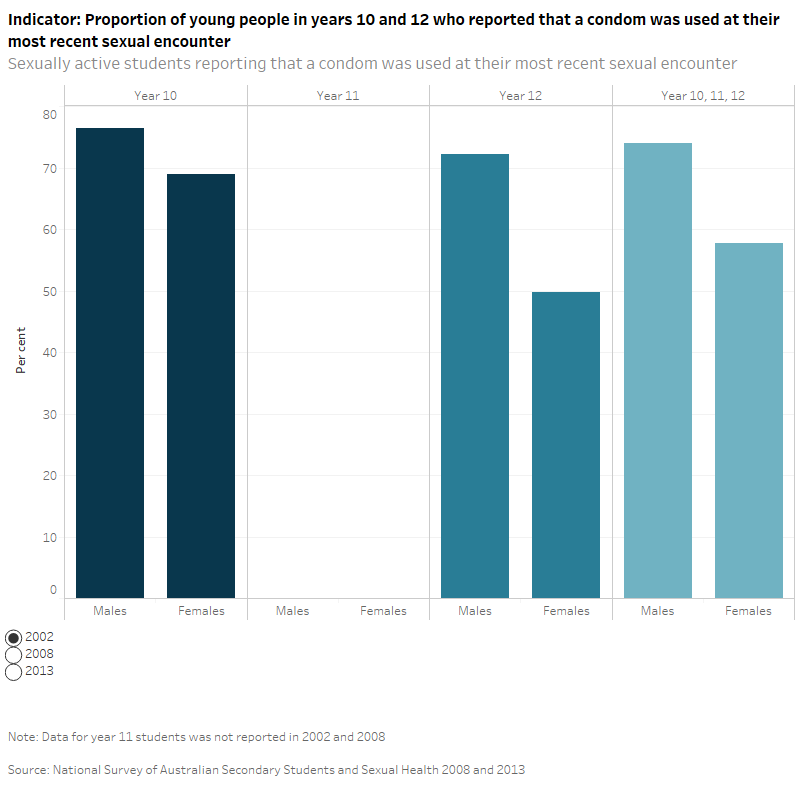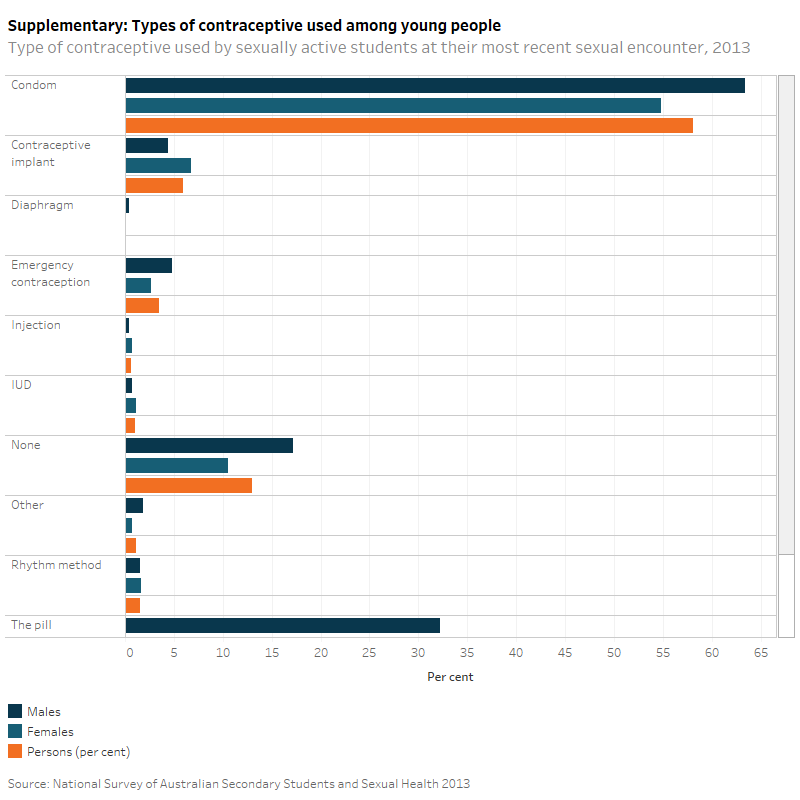Contraceptive use
Why are rates of contraceptive use important?
Sexual development is a natural part of progressing to adulthood, and the majority of young sexually active Australians practice safe sex (Mitchell et al. 2014). However, unprotected intercourse may result in the transmission of sexually transmissible infections (STIs) such as chlamydia, gonorrhoea, HIV, syphilis, and can result in unplanned pregnancy (AIHW 2014). It is also associated with increased risk of some cancers, including cervical cancer and anal cancer (AIHW 2010).
The success of lowering unwanted pregnancies and the prevalence of STIs among young people relies heavily on the knowledge about reproductive matters and access to and use of effective contraception. Use of condoms is the most effective method of protection against STIs among sexually active people, and is effective in preventing unintended pregnancies.
See also Sexually transmissible infection, HIV infection, Cervical cancer prevention and Teenage mothers.
Do rates of contraceptive use vary across population groups?
In 2013, 65% of sexually active males and 55% of sexually active females in Years 10 to 12 reported using a condom at their most recent sexual encounter. About 72% of students in Year 10 reported that a condom was used at their last sexual encounter, compared to 57% of students in Year 11, and 52% of students in Year 12.
Of the types of contraceptives, sexually active students in Years 10 to 12 were more likely to report that a condom had been used at their most recent sexual encounter (58%). The pill was also a commonly reported form of contraception used among young people in their last sexual encounter (38%). In 2013, 15% of young people reported using the withdrawal method as a form of contraception at their most recent sexual encounter. About 13% of young people reported that no contraception was used at their most recent sexual encounter.
Has there been a change over time?
The proportion of sexually active students in Year 10 and 12 who reported that a condom was used at the most recent sexual encounter has remained relatively stable from 2002 to 2008 at around 65%. Of students in year 12, there was no change in condom use at the most recent sexual encounter by all students (60%). The proportion of sexually active students in year 10 reporting that a condom was used at the most recent sexual encounter has remained relatively steady during this period at around 70% for all young people.
The proportion of young people reporting that the contraceptive pill was used at the most recent sexual encounter increased by a third from 2002 to 2008 (from 37% to 50%). The proportion of young people reporting that the withdrawal method was used at the most recent sexual encounter decreased slightly from 12% in 2002 to 9.5% in 2008. These trends are accompanied by reductions in the proportion of those reporting that no contraception was used, which decreased from 9.4% in 2002 to 0.2% in 2008.


This report is based on survey data; relative standard errors and 95% confidence intervals were not provided with the source data. Consequently, significance testing has not been undertaken.
For data relating to type of contraceptive method used at the most recent sexual encounter, some students reported more than one method of contraception and therefore components will not sum to 100%.
For 2002, 2008, the study used a representative random sample of schools based on Australian Bureau of Statistics data. Participating schools invited students to complete the survey. In 2013, additional students were recruited via an online survey that was independent of school recruitment, and is therefore considered to be a convenience sample. Due to differences in sampling methodology, 2013 data are not compared to earlier years.
National Survey of Australian Secondary Students and Sexual Health 2008
National Survey of Australian Secondary Students and Sexual Health 2013
Data quality statement: Not available, please see the published source (above) for further information
AIHW (Australian Institute of Health and Welfare) 2010. Australia’s health 2010: Australia’s health series no. 12. Cat. no. AUS122. Canberra: AIHW.
Australian Institute of Health and Welfare 2014. Australia’s health 2014. Australia’s health series no. 14. Cat. no. AUS 178. Canberra: AIHW.
Mitchell A, Patrick K, Heywood W, Blackman P, Pitts M. 2014. 5th National Survey of Australian Secondary Students and Sexual Health 2013, (ARCSHS Monograph Series No. 97), Australian Research Centre in Sex, Health and Society, La Trobe University, Melbourne, Australia.


